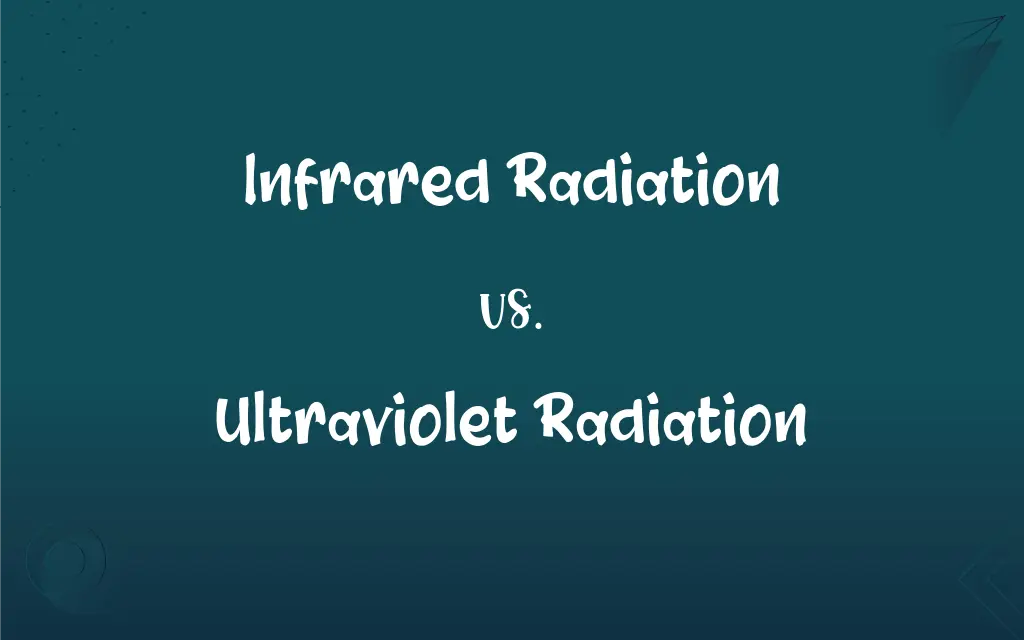Infrared Radiation vs. Ultraviolet Radiation: What's the Difference?
Edited by Aimie Carlson || By Janet White || Published on March 19, 2024
Infrared radiation is electromagnetic radiation with wavelengths longer than visible light, used for heating and night vision; ultraviolet radiation has shorter wavelengths, causing sunburn and used for sterilization.

Key Differences
Infrared radiation and ultraviolet radiation are both forms of electromagnetic radiation, differing primarily in their wavelength, energy, and effects on matter. Infrared radiation exists just beyond the visible spectrum's red end, characterized by longer wavelengths ranging from about 700 nanometers to 1 millimeter. Ultraviolet radiation, on the other hand, lies at the opposite end of the visible spectrum, beyond violet light, with wavelengths ranging from 10 to 400 nanometers. Ultraviolet radiation carries more energy than infrared radiation due to its shorter wavelengths.
The sources of infrared and ultraviolet radiation also differ significantly. Infrared radiation is produced by objects emitting heat, which includes everything from stars and planets to living organisms and artificial heaters. Its presence is ubiquitous in the everyday environment, utilized in a variety of technologies from remote controls to thermal cameras. Ultraviolet radiation is primarily sourced from the sun, with artificial sources including black lights and UV sterilization lamps. While not visible to the human eye, its effects are felt in both beneficial and harmful ways.
In terms of applications, infrared radiation is widely used in heating, night vision technology, remote controls, and medical imaging, exploiting its ability to interact with matter through heat. Ultraviolet radiation finds its applications in sterilization, fluorescent lighting, and detecting counterfeit money, among others, leveraging its ability to cause chemical reactions and fluoresce certain materials.
Despite their differences, both types of radiation play crucial roles in the Earth's energy balance and have significant technological, medical, and environmental applications. Understanding the properties, sources, and effects of infrared and ultraviolet radiation is essential for harnessing their benefits while mitigating risks associated with exposure.
Comparison Chart
Wavelength
Longer wavelengths (700 nm to 1 mm)
Shorter wavelengths (10 nm to 400 nm)
ADVERTISEMENT
Energy
Lower energy
Higher energy
Source
Heat emission from objects
Sun, black lights, sterilization lamps
Applications
Heating, night vision, remote controls, medical imaging
Sterilization, fluorescent lighting, vitamin D synthesis
Health Effects
Generally safe, used for therapeutic heating
Can cause skin cancer, sunburn, eye damage
Infrared Radiation and Ultraviolet Radiation Definitions
Infrared Radiation
Electromagnetic radiation with wavelengths longer than visible light, felt as heat.
The warmth on your skin under the sun is due to infrared radiation.
ADVERTISEMENT
Ultraviolet Radiation
Essential for the body's production of vitamin D.
Moderate exposure to ultraviolet radiation from sunlight helps your skin produce vitamin D.
Infrared Radiation
A type of radiation used in remote controls to send signals.
Your TV remote uses infrared radiation to communicate with the television.
Ultraviolet Radiation
Can damage DNA, leading to skin cancer with prolonged exposure.
Protecting your skin from excessive ultraviolet radiation can reduce the risk of skin cancer.
Infrared Radiation
Utilized in night vision equipment to see in the dark.
Soldiers use night vision goggles that detect infrared radiation to navigate at night.
Ultraviolet Radiation
Electromagnetic radiation with shorter wavelengths than visible light, causing sunburn.
Ultraviolet radiation from the sun is strongest during midday, increasing the risk of sunburn.
Infrared Radiation
Radiation emitted by all objects based on their temperature.
Infrared cameras can detect people in complete darkness by their infrared radiation.
Ultraviolet Radiation
Radiation used to sterilize medical equipment by destroying bacteria.
Hospitals use ultraviolet radiation to ensure their instruments are germ-free.
Infrared Radiation
Applied in physical therapy to provide deep tissue warmth.
Infrared lamps in physical therapy help relieve muscle pain.
Ultraviolet Radiation
A type of radiation that can cause materials to fluoresce.
Banknote security features often use ultraviolet radiation to check for authenticity.
FAQs
What is infrared radiation?
Infrared radiation is electromagnetic radiation with wavelengths longer than visible light, associated with heat.
How do humans use infrared radiation?
Humans use infrared radiation for heating, in remote controls, for night vision, and in medical imaging.
Can infrared radiation be seen by humans?
No, infrared radiation is not visible to the human eye but can be felt as heat.
What are the dangers of ultraviolet radiation?
Ultraviolet radiation can cause skin cancer, sunburn, and eye damage with prolonged exposure.
Is infrared radiation harmful?
Infrared radiation is generally safe, though excessive exposure can cause skin burns or eye damage in extreme cases.
Why is ultraviolet radiation used for sterilization?
Ultraviolet radiation is used for sterilization because it can destroy bacteria and viruses.
What devices emit infrared radiation?
Devices that emit infrared radiation include heaters, remote controls, and thermal imaging cameras.
How does ultraviolet radiation affect the skin?
Ultraviolet radiation can cause sunburn, premature aging, and increase the risk of skin cancer.
Can infrared radiation be used in therapy?
Yes, infrared radiation is used in therapeutic settings for its deep tissue heating effects.
What is ultraviolet radiation?
Ultraviolet radiation is electromagnetic radiation with shorter wavelengths than visible light, known for its ability to cause sunburn.
What is the difference between infrared and ultraviolet radiation in terms of wavelength?
Infrared radiation has longer wavelengths than visible light, while ultraviolet radiation has shorter wavelengths.
How does the ozone layer relate to ultraviolet radiation?
The ozone layer absorbs most of the sun's harmful ultraviolet radiation, protecting life on Earth.
What precautions should be taken against ultraviolet radiation?
Precautions include wearing sunscreen, sunglasses, and protective clothing, especially during peak sun hours.
Why is ultraviolet radiation harmful to the eyes?
Ultraviolet radiation can damage the cornea and lens, leading to cataracts and other eye issues.
How do night vision goggles use infrared radiation?
Night vision goggles detect infrared radiation emitted by objects, converting it into a visible image.
Are all sources of infrared radiation artificial?
No, natural sources of infrared radiation include the sun, fire, and living organisms.
How can one safely benefit from ultraviolet radiation?
Benefiting safely from ultraviolet radiation involves moderate sun exposure and using protection to minimize skin damage.
How does ultraviolet radiation produce vitamin D?
Ultraviolet radiation from the sun stimulates the production of vitamin D in the skin.
What materials can block ultraviolet radiation?
Materials like glass, certain plastics, and clothing with UV protection can block ultraviolet radiation.
Can animals see infrared radiation?
Some animals, like certain snakes and insects, can detect infrared radiation, which helps them find prey or navigate.
About Author
Written by
Janet WhiteJanet White has been an esteemed writer and blogger for Difference Wiki. Holding a Master's degree in Science and Medical Journalism from the prestigious Boston University, she has consistently demonstrated her expertise and passion for her field. When she's not immersed in her work, Janet relishes her time exercising, delving into a good book, and cherishing moments with friends and family.
Edited by
Aimie CarlsonAimie Carlson, holding a master's degree in English literature, is a fervent English language enthusiast. She lends her writing talents to Difference Wiki, a prominent website that specializes in comparisons, offering readers insightful analyses that both captivate and inform.
































































